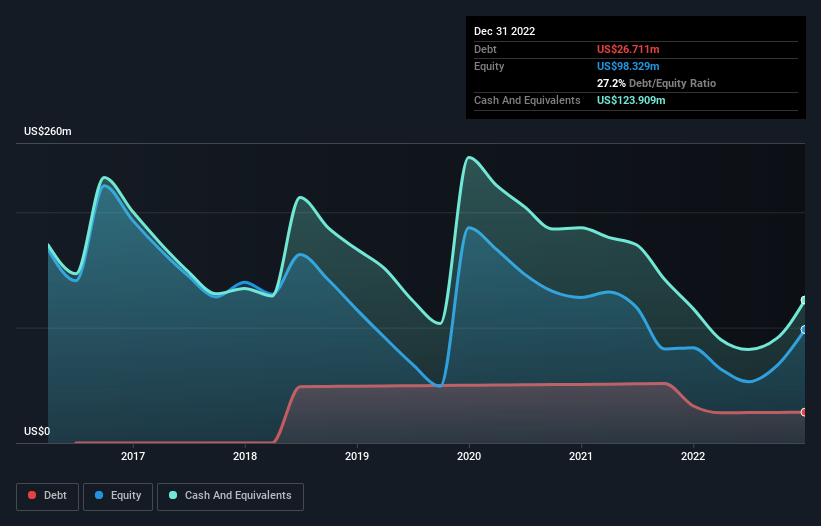
Some say volatility, rather than debt, is the best way to think about risk as an investor, but Warren Buffett famously said that 'Volatility is far from synonymous with risk.' It's only natural to consider a company's balance sheet when you examine how risky it is, since debt is often involved when a business collapses. We can see that Ardelyx, Inc. (NASDAQ:ARDX) does use debt in its business. But the more important question is: how much risk is that debt creating?
What Risk Does Debt Bring?
Generally speaking, debt only becomes a real problem when a company can't easily pay it off, either by raising capital or with its own cash flow. Part and parcel of capitalism is the process of 'creative destruction' where failed businesses are mercilessly liquidated by their bankers. While that is not too common, we often do see indebted companies permanently diluting shareholders because lenders force them to raise capital at a distressed price. Of course, debt can be an important tool in businesses, particularly capital heavy businesses. The first thing to do when considering how much debt a business uses is to look at its cash and debt together.
Check out our latest analysis for Ardelyx
What Is Ardelyx's Debt?
You can click the graphic below for the historical numbers, but it shows that Ardelyx had US$26.7m of debt in December 2022, down from US$32.3m, one year before. However, its balance sheet shows it holds US$123.9m in cash, so it actually has US$97.2m net cash.

A Look At Ardelyx's Liabilities
We can see from the most recent balance sheet that Ardelyx had liabilities of US$65.6m falling due within a year, and liabilities of US$26.1m due beyond that. On the other hand, it had cash of US$123.9m and US$7.73m worth of receivables due within a year. So it actually has US$39.9m more liquid assets than total liabilities.
This surplus suggests that Ardelyx has a conservative balance sheet, and could probably eliminate its debt without much difficulty. Simply put, the fact that Ardelyx has more cash than debt is arguably a good indication that it can manage its debt safely. There's no doubt that we learn most about debt from the balance sheet. But it is future earnings, more than anything, that will determine Ardelyx's ability to maintain a healthy balance sheet going forward. So if you want to see what the professionals think, you might find this free report on analyst profit forecasts to be interesting.
Over 12 months, Ardelyx reported revenue of US$52m, which is a gain of 417%, although it did not report any earnings before interest and tax. When it comes to revenue growth, that's like nailing the game winning 3-pointer!
So How Risky Is Ardelyx?
Statistically speaking companies that lose money are riskier than those that make money. And the fact is that over the last twelve months Ardelyx lost money at the earnings before interest and tax (EBIT) line. And over the same period it saw negative free cash outflow of US$70m and booked a US$67m accounting loss. While this does make the company a bit risky, it's important to remember it has net cash of US$97.2m. That kitty means the company can keep spending for growth for at least two years, at current rates. Importantly, Ardelyx's revenue growth is hot to trot. High growth pre-profit companies may well be risky, but they can also offer great rewards. The balance sheet is clearly the area to focus on when you are analysing debt. But ultimately, every company can contain risks that exist outside of the balance sheet. For instance, we've identified 3 warning signs for Ardelyx (1 shouldn't be ignored) you should be aware of.
If, after all that, you're more interested in a fast growing company with a rock-solid balance sheet, then check out our list of net cash growth stocks without delay.
New: Manage All Your Stock Portfolios in One Place
We've created the ultimate portfolio companion for stock investors, and it's free.
• Connect an unlimited number of Portfolios and see your total in one currency
• Be alerted to new Warning Signs or Risks via email or mobile
• Track the Fair Value of your stocks
Have feedback on this article? Concerned about the content? Get in touch with us directly. Alternatively, email editorial-team (at) simplywallst.com.
This article by Simply Wall St is general in nature. We provide commentary based on historical data and analyst forecasts only using an unbiased methodology and our articles are not intended to be financial advice. It does not constitute a recommendation to buy or sell any stock, and does not take account of your objectives, or your financial situation. We aim to bring you long-term focused analysis driven by fundamental data. Note that our analysis may not factor in the latest price-sensitive company announcements or qualitative material. Simply Wall St has no position in any stocks mentioned.
About NasdaqGM:ARDX
Ardelyx
Ardelyx, Inc. discovers, develops, and commercializes medicines to treat unmet medical needs in the United States and internationally.
Exceptional growth potential and undervalued.
Market Insights
Community Narratives



